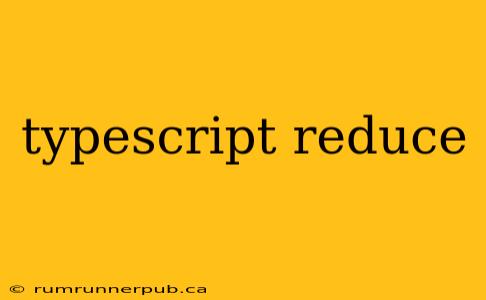The reduce method is a powerful array function available in JavaScript and, by extension, TypeScript. It allows you to process an array and accumulate a single result. While seemingly simple, understanding its nuances unlocks significant power in data manipulation. This article will explore reduce in TypeScript, drawing upon insightful questions and answers from Stack Overflow, and adding practical examples and explanations to solidify your understanding.
Understanding the Fundamentals
The reduce method iterates over an array, applying a callback function to each element and accumulating the result. The callback function takes four arguments:
- accumulator: The accumulated value from the previous iteration. On the first iteration, this is either the initial value you provide (see below) or the first element of the array.
- currentValue: The current element being processed.
- currentIndex: The index of the current element.
- array: The original array.
The reduce method's signature in TypeScript can be represented as:
array.reduce(callbackFn: (accumulator: any, currentValue: any, currentIndex: number, array: any[]) => any, initialValue?: any): any;
Note the initialValue parameter. Providing an initialValue is crucial for controlling the initial state of the accumulator. Omitting it will use the first array element as the initial value, and the iteration will start from the second element.
Stack Overflow Insights and Practical Applications
Let's delve into some real-world scenarios illuminated by Stack Overflow questions:
Scenario 1: Summing Array Elements
A common use case is summing numbers in an array. A Stack Overflow question might ask: "How to sum numbers in a TypeScript array using reduce?"
Stack Overflow-inspired solution:
const numbers: number[] = [1, 2, 3, 4, 5];
const sum: number = numbers.reduce((acc, curr) => acc + curr, 0); // 0 is the initial value
console.log(sum); // Output: 15
Analysis: Here, the accumulator (acc) starts at 0. In each iteration, the current value (curr) is added to it. The final result is the sum of all elements. Using an initial value of 0 explicitly handles the case of an empty array, preventing errors.
Scenario 2: Object Aggregation
Suppose you have an array of objects and want to group them by a specific property. A Stack Overflow question might address this challenge.
Stack Overflow-inspired solution (with improvements):
interface Person {
name: string;
age: number;
city: string;
}
const people: Person[] = [
{ name: 'Alice', age: 30, city: 'New York' },
{ name: 'Bob', age: 25, city: 'Los Angeles' },
{ name: 'Charlie', age: 35, city: 'New York' },
];
const peopleByCity = people.reduce((acc, curr) => {
acc[curr.city] = acc[curr.city] || []; //If the city doesn't exist create an empty array
acc[curr.city].push(curr);
return acc;
}, {} as { [city: string]: Person[] });
console.log(peopleByCity);
// Output: { 'New York': [ { name: 'Alice', age: 30, city: 'New York' }, { name: 'Charlie', age: 35, city: 'New York' } ], 'Los Angeles': [ { name: 'Bob', age: 25, city: 'Los Angeles' } ] }
Analysis: This example demonstrates how reduce can be used for more complex aggregation tasks. The accumulator is an object where keys are cities and values are arrays of people living in those cities. The || [] ensures that if a city is encountered for the first time, an empty array is created before pushing the person object. Explicit typing with {} as { [city: string]: Person[] } enhances code clarity and type safety.
Scenario 3: Flattening Nested Arrays
Another common use case involves flattening nested arrays. A Stack Overflow thread might discuss efficient ways to achieve this.
Stack Overflow-inspired solution:
const nestedArray: number[][] = [[1, 2], [3, 4], [5, 6]];
const flattenedArray: number[] = nestedArray.reduce((acc, curr) => acc.concat(curr), []);
console.log(flattenedArray); // Output: [1, 2, 3, 4, 5, 6]
Analysis: The concat method is used within the reduce callback to append the current sub-array to the accumulator, effectively flattening the nested array. Starting with an empty array as the initial value is essential. Note that this approach creates new arrays in each iteration. For extremely large arrays, consider alternative, potentially more performant approaches.
Conclusion
TypeScript's reduce method is a versatile tool for array manipulation. By understanding its fundamentals and leveraging examples inspired by Stack Overflow discussions, you can effectively utilize it to solve a wide array of data processing challenges. Remember to always consider the initial value and the type safety aspects for robust and efficient code. Exploring various use cases and adapting the examples provided will further enhance your proficiency with this essential function.
